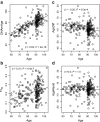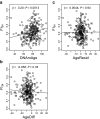The frailty index outperforms DNA methylation age and its derivatives as an indicator of biological age
- PMID: 28299637
- PMCID: PMC5352589
- DOI: 10.1007/s11357-017-9960-3
The frailty index outperforms DNA methylation age and its derivatives as an indicator of biological age
Abstract
The measurement of biological age as opposed to chronological age is important to allow the study of factors that are responsible for the heterogeneity in the decline in health and function ability among individuals during aging. Various measures of biological aging have been proposed. Frailty indices based on health deficits in diverse body systems have been well studied, and we have documented the use of a frailty index (FI34) composed of 34 health items, for measuring biological age. A different approach is based on leukocyte DNA methylation. It has been termed DNA methylation age, and derivatives of this metric called age acceleration difference and age acceleration residual have also been employed. Any useful measure of biological age must predict survival better than chronological age does. Meta-analyses indicate that age acceleration difference and age acceleration residual are significant predictors of mortality, qualifying them as indicators of biological age. In this article, we compared the measures based on DNA methylation with FI34. Using a well-studied cohort, we assessed the efficiency of these measures side by side in predicting mortality. In the presence of chronological age as a covariate, FI34 was a significant predictor of mortality, whereas none of the DNA methylation age-based metrics were. The outperformance of FI34 over DNA methylation age measures was apparent when FI34 and each of the DNA methylation age measures were used together as explanatory variables, along with chronological age: FI34 remained significant but the DNA methylation measures did not. These results indicate that FI34 is a robust predictor of biological age, while these DNA methylation measures are largely a statistical reflection of the passage of chronological time.
Keywords: Aging; Biological age; DNA methylation; Frailty; Mortality.
Conflict of interest statement
The authors declare that they have no conflict of interest.
Figures



References
Publication types
MeSH terms
Grants and funding
LinkOut - more resources
Full Text Sources
Other Literature Sources
Medical

